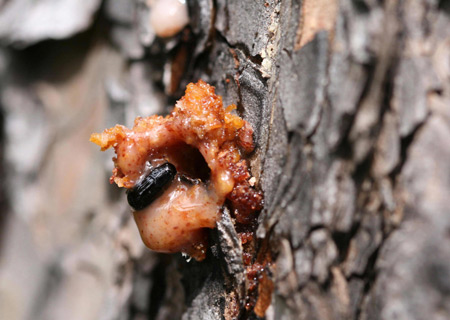David May, Communications Intern
Since the ‘90s, the scenic views of North America’s lushest western forests have become more and more splattered with a palette of rust and dark grey. Once only patches amongst the vast swathes of evergreen, entire mountainsides now stand barren. This widespread problem has many culprits, but perhaps the most infamous among them is the mountain pine beetle.
Another Ecosystem Unbalanced
Unlike many other insect blights, the mountain pine beetle is a non-invasive species, having coexisted with the forests they’ve now been destroying for many years. They inhabit many species of pine in ecosystems ranging from Mexico to British Columbia, and their reach is steadily growing. The trees they target have long since adapted to fight them, and, until relatively recently, the beetle was constrained to only minor outbreaks by the trees’ adaptive defenses and the killing frost of winter.

However, this complex relationship has been upset by climate change, just like countless others around the globe. The rise in temperatures has opened up mountain-tops and other areas to the mountain pine beetle’s reach. This abundance of new resources, combined with less harsh winters and the increased amount of stress that drought and rising temperatures have put on trees, has led to a vicious cycle of infestation that has left enormous tracts of dead forest in its wake. Dead trees are some of the best fuel for a raging wildfire, making for a very dangerous combination with the ongoing drought.
The severity of this issue puts the mountain pine beetle at the top of the forestry service’s list. America and Canada have both been pouring funds into various programs in an effort to tamp down on the economic havoc that this bug has caused for the forestry and recreational industries of the west. In fact, the mountain pine beetle was the second beetle to ever have its genome sequenced, in an attempt to gain insight on how to best deal with this scourge.
Halting the Spread
Canada especially is going on the defensive. Having ravaged most of British Columbia (B.C.), the beetle has spread east into Alberta, and Canada’s boreal forests have a lot to lose. The lodgepole pine has been the predominant victim of choice for the beetle throughout the west, but as it has almost exhausted the available lodgepole population, it has begun to colonize other species. Now, it is reproducing in the jack pine, the major pine species of the boreal forest. This is a new environment for the mountain pine beetle, so it is difficult to predict exactly how it will spread. B.C. is projected to have lost 58% of all usable pine because of the beetle by 2017, and Canada is anxious to keep the threat from similarly spreading to other provinces.1

Alberta’s highest priority for the mountain pine beetle is, above all else, containment. Any time a new infestation is detected, the area is immediately targeted to eradicate the beetle before the group can mature enough to fly again. This can be done by selective or area logging through various Forest Management Agreements that the Alberta Sustainable Resource Development office has with various companies and stakeholders. Much of this timber can still be used for various commercial purposes if harvested promptly enough. However, responding to these threats in a timely manner is tricky when trying to negotiate holding agreements with various parties and still attempting to meet long-term forestry goals.
Despite the destruction that the advance of the mountain pine beetle has caused, hope is found in new research being conducted. At the University of Alberta, pheromone “bait” is being studied to monitor and eventually trap beetles in certain areas. There is also promise in manipulating the various fungi that the beetles rely on to provide the nutrition they require. We at American Forests are doing our best to help as well, through our Endangered Western Forests program. With so much at stake, organizations of all kinds have come together to form a robust network of knowledge and resources. However, one thing is certain: the mountain pine beetle must be stopped.
More information on the mountain pine beetle outbreak can be found here!
Works Cited
- “Mountain pine beetle (factsheet).” Natural Resources Canada. Government of Canada, n.d. Web. 07 July 2015